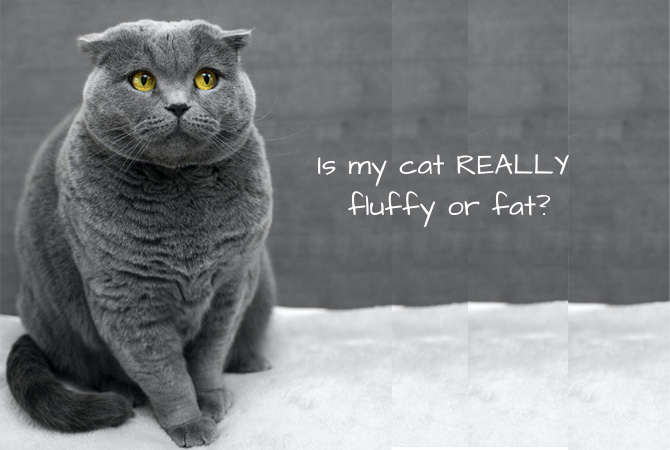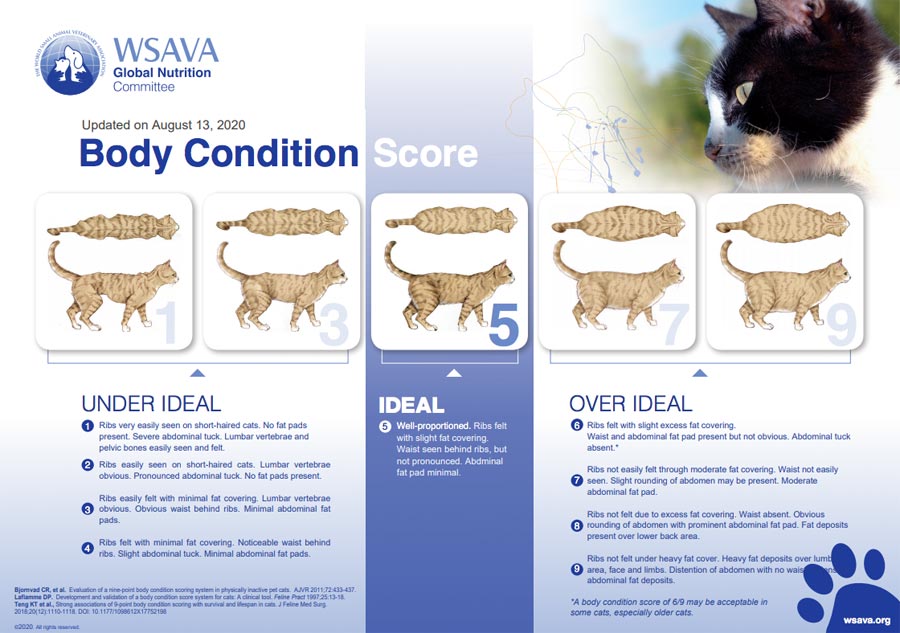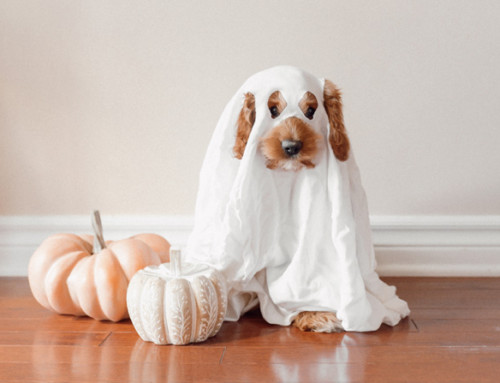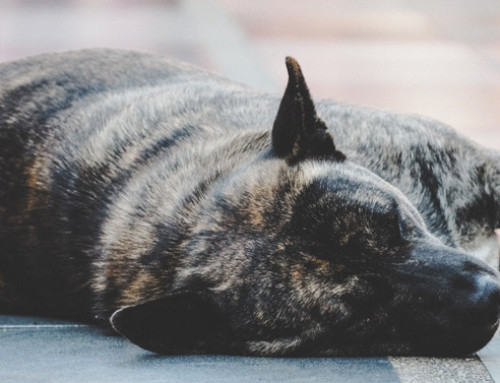While you might think your overweight cat is cute and cuddly, the truth is your feline friend’s health is at risk. Obese or overweight cats are at higher risk of many health problems including diabetes, arthritis and heart disease. What’s more, your tubby tabby faces a shorter life span than its leaner meowing mate.
Is my cat fat or just REALLY fluffy?
Now, that’s an excellent question, and I’m pleased you asked! It’s important to be able to recognise when your purring pal is on the chubby side. Indeed, many pet owners simply believe their cat is a ‘big ‘ol cat’ or that Felix just has LOTS of fur. They fail to realise their cat is not supposed to be this large and that, in fact, their cat is fat.
Certainly, having an overweight cat can cause a pet owner to feel guilty. We all like to consider ourselves to be good pet parents and admitting we’ve allowed our feline friend to get fat can be hard. However, just like in humans, carrying excess fat can lead to many issues as it puts added stress on joints, and major organs. So, keeping track of your cat’s weight will help your fur pal live a happy and healthy life. Here are a few tips to help you work out if your cat is fat or whether he is just super fluffy!
How to use the Body Condition Score
Pop the words ‘cat body condition score’ into Google search and you’ll come up with all manner of useful charts to check your cat’s weight. The chart I like to refer to is the World Small Animal Veterinary Association (WSAVA) Body Condition Score. It makes it easy to see, at a glance, whether your meowing mate falls within the ideal weight range.
The score ranges from one to nine. One indicates your cat is underweight and nine suggests you have an overweight cat. Finding out your cat’s body condition score is a puurfect way to work out whether you need to take action.
TIP: If you’re looking for a quick way to determine whether or not your cat’s weight is ideal, here’s how. Gently run a flat palm along your four-legged friend’s ribcage. If you can feel the ribs but they’re not visible this indicates your cat is a good weight. Yay! But, if the ribs are visible or you have to press your hand down quite firmly to feel the ribs, this might suggest your cat is underweight or overweight.
Also, take a look at your fur pal from the side and from above. You should be able to see its waist. If there’s no waist to be seen, your cat may be on the porky side!
Of course, this is just a guide. There are also things like stomach fat and vertebrae and muscle mass to consider. If you are concerned about your cat’s weight, it is worthwhile taking Kitty on a trip to your local vet.
What can you do to help your overweight cat?
The two most important factors when helping an overweight kitty lose weight are diet and exercise. Let’s start with diet…
One of the simplest ways to help your overweight cat is to write down everything you feed Fluffy during the whole day. Yes, that includes those sneaky little titbits he loves! This will give you a very real and clear idea of where you might be going wrong.
The best course of action is to discuss with your vet a calorie-reduced meal plan. A vet will take into consideration your cat’s age, lifestyle, and weight to determine how many calories your purring pal should be eating each day.
Typically, canned food is recommended, as this is lower in calories but higher in water and protein than dry food. Some cats may be put on a special high-fibre diet, as this will help them to feel fuller for longer. Other cats may benefit from certain nutrients to help boost their metabolism and burn more calories. Given that there are so many different types of diets, it really is best to chat to your vet and find an option that best suits your individual cat.
At home tips
- To help an overweight cat to shed a few pounds it can be beneficial to feed controlled meals, rather than leaving food down all day.
- Rather than giving your fur pal treats, pet or play with your feline.
- Give fresh water regularly throughout the day to help encourage your cat to drink, which may reduce food cravings.
- Be aware that slow, steady weight loss is best. It can take up to a year for a cat to reach its ideal weight.
- Make sure you factor any treats you give into your cat’s daily calorie intake. This might mean reducing the amount of normal food you give.
Keeping your purring pal’s weight in check with exercise
Alongside diet, the second most important factor when helping your cat lose weight or keeping his weight in check is exercise. A pawsome way to assist an overweight cat while also increasing their physical activity is to introduce food puzzles and feeding toys. These increase the amount of time they take to eat their food, helping our feline friends stay full for longer, while also giving our purring pals exercise.
Cats love to search for prey, so why not encourage your kitty to search for his or her food. Move the bowl to different locations in the home to keep your cat on the move.
Particularly if your cat spends most of its time indoors, it’s essential to ensure he or she is getting enough exercise. Playing is a great way to keep your meowing mate active. Here are 10 games that are sure to be heaps of fun for you and your feline friend.
Happy cat parenting!
Information sources
Williams, K. Creating a weight reduction plan for cats. VCA Hospitals. Accessed online via: https://vcahospitals.com/know-your-pet/creating-a-weight-reduction-plan-for-cats
Cats Protection UK. Cat obesity. Accessed online via: https://www.cats.org.uk/help-and-advice/diet/cat-obesity








Leave A Comment